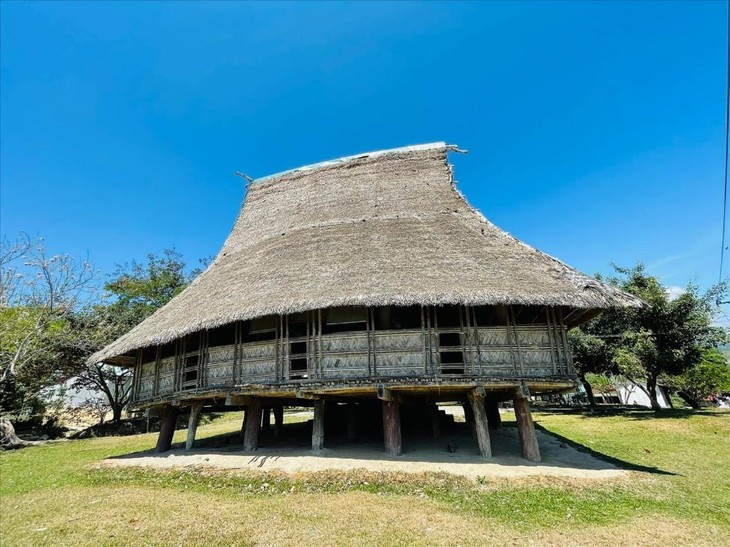The Central Highlands province of Kon Tum is inhabited by 6 indigenous ethnic minorities, including the Gie Trieng. Clustering mainly in Ngọc Hoi and Dak Glei district, the Gie Trieng have preserved their ancient culture and customs.

The Rong house of the Gie Trieng (photo: baodantoc.vn)
The Gie Trieng live in villages in long stilt houses built around a communal house. A Gie Trieng stilt house is divided by a passage, with one side reserved for men and the other side for women.
A Mon of Dak Rang village, Ngoc Hoi district, said: “The main house usually has 3 compartments. The space for old people is closer to the wood stove to keep them warm. The parents’ area is farther from the stove. Young people and children sleep furthest from the stove. In the past, people slept on mats with no partition to divide the space.”
The Gie Trieng in Kon Tum province build stilt houses with curved roofs like turtle shells. The gables are decorated with two buffalo horns, said A Mon.
“A Gie Trieng house looks like a huge buffalo standing in the village. The house’s strong frame is made of wood.”
The Gie Trieng believe that a buffalo is neither a production tool nor food. The buffalo is a sacred animal, an offering to the gods to show people’s respect and reverence for the supreme being. Since ancient times, the stilt house of the Gie Trieng has borne the image of a buffalo.
A Mon says the most important part of the house is the kitchen. “Fire is very important in the house of the Gie Trieng. There must be a wood stove and a place to store seeds, meat, and woven items. A durable house must have a fire to blow hot air onto the thatched roof. The worship space is all close to the kitchen in the middle of the house. Next to the kitchen is the main pillar supporting the roof of the house. Whatever is hunted is hung on this pillar.”
The Rong communal house is highly valued by the Gie Trieng. They carefully choose a place to build the house, usually at the end of the village, on a high, flat, spacious area, with an open view on all sides.
From the communal house, one can observe most of the village. In front of the communal house is a large yard for community get-togethers. Made from natural materials, such as wood, thatch, bamboo, and rattan like the stilt house of other ethnic groups, the Gie Trieng communal house holds the soul of the village - a buffalo soul, said A Mon.
“The buffalo is a sacred animal that is indispensable in the life of the Gie Trieng. It connects the gods with humans, and represents the unique culture of the group. The Gie Trieng people hold rituals to offer a buffalo to the gods to pray for a bountiful harvest.”
The communal house of the Gie Trieng is built on a sturdy wooden frame, usually consisting of 10 main pillars of durable, termite-resistant trees. The main pillars are round from the ground to the floor of the house. From the floor to the roof, the pillars are rectangular, A Mon said.
“Building a communal house is quite difficult. We cut the trees from the forest and use axes to chisel and carve them by hand. Each tree makes one pillar. It takes many people to erect the pillars to make the frame.”
Both sides of the Rong house a two fan-shaped structure supported by 3 to 5 pillars and thatched in a beautiful rounded shape, which is different from the square corners of the axe-shaped roofs of other ethnic stilt houses, according to A Mon .
“The Rong house of the Gie Trieng is not tall. The floor on stilts is as high as an adult's chin to avoid wild animals and rain. The roof looks like a buffalo's back or a turtle's shell.”
The Gie Trieng communal house is decorated with wood carvings of buffalo horns. At the entrance are buffalo horns or wild boar heads, a sacrifice to the gods and the symbol of the village’s strength and spirituality. Since ancient times, the communal house has been built with the combined strength and enthusiasm of the whole community, a spiritual fortress to protect the village.
Lam Thanh - Vinh Phong
















